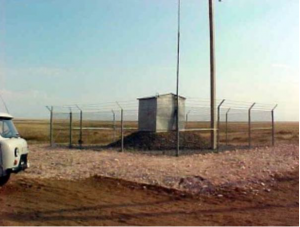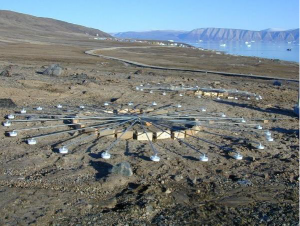EARTH MAGNITUDE
The sensors of the IMS reveal human and seismic activity as geological forces operating at the scale of the earth, or in other words; at the scale of earth magnitude. However, what is earth magnitude? And what does it mean to think at earth magnitude? Earth magnitude is first introduced by academic Douglas Kahn in his book ‘Earth Sound Earth Signal: Energies and Earth Magnitude in the Arts’ (2013). In this book, Kahn uses the term earth magnitude to relate energies to the scales of the earth — from sound at local and long distances, to the effects of electrical atmospheres, to electromagnetic activities occurring at the speed of light at earth magnitude.[9] Kahn investigates several energy related artistic and scientific projects, such as the natural radio of Alvin Lucier, Gordon Mumma’s seismic music and the whistler phenomenon. A whistler is a low frequency wave generated by bursts of lightning. Although they are electromagnetic waves, they occur at audio frequencies, and can be converted to audio using a suitable receiver.[10] Whistlers bounce back and forth between the earth and the ionosphere. At a height of 600km, ‘they arch over the equator and form globetrotting signals; earth magnitude signals in their truest sense’.[9] Whistler science evolved out of the military communications of World War I and, along with geophysical sciences generated new scientific means of sensing physical phenomena and energetic states of the earth at a geophysical scale.[9] In a late nineteenth-century contest to sense the scale of the earth, the main contenders were of acoustical nature: the eruption of the Krakatoa was heard thousands of kilometers away from its source and seismic signals from an earthquake in Japan hit seismographs in Germany. Both were means to sense the ‘whole earth’ before technological surveillance aircraft and ‘blue marble’ photographs from space took over sensing practices.[9] Through the investigation of energy related artistic and scientific projects, Kahn reveals earth magnitude as a large scale, dense entity filled with electromagnetic currents, weather systems, terrestrial activities, and radio waves, made visible through years of artistic expression.
Philosopher Timothy Morton elaborates further on earth magnitude by stating that thinking at earth magnitude is thinking at a scale sufficient to open the concept of earth to the true extend of its range.[11] Global climate does this, as terrestrial weather events are caused by a massive entity that exists at earth magnitude. Solar storms do this as they interact with earth’s magnetic shields and produce auroras. ‘Human thought at Earth magnitude is human thinking that is as ‘large’ as the aurora. It is a thought that can think the aurora in such a way that its vastness is witnessed and opened in us’.[11]
According to Morton, at earth magnitude, anthropocentric distinctions don’t matter anymore. These distinctions include binaries such as here vs there, person vs thing, individual vs group and life vs non-life. Thinking at earth magnitude allows us to see human species and activity not as a thing we can ontically point to, but as something like the aurora, a mysterious yet distinct entity. Morton proposes to see human activity, with all its dense energies as an hyperobject that is real, yet inaccessible.[11] Morton uses the term ‘hyperobjects’ to describe vast entities that ‘are massively distributed in time and space and transcend spatiotemporal specificity; such as global warming and the atmosphere’. [12] It is the notion of the hyperobject that provides a way to think entities at earth magnitude, hyperobjects are real entities that cannot be seen, touched or grasped. ‘They are beyond the human, but they are not infinite or abstract, they are just very, very big’.[11]
/index.php/summary/article/view/28/29)
Figure 5. Infrasound station (https://en.wikipedia.org/wiki/Infrasound#
/media/File:Infrasound_Arrays.jpg)
Ultimately, the notion of the Hyperobject reveals earth magnitude as a massive entity that is filled with energy and activity and is massively distributed in time and space. The sensors of the IMS expose earth’s atmosphere as filled with anthropogenic human activity and the earth itself as filled with geological-time seismic activity. Moreover, earth magnitude allows us to think at the true extend of earth’s range, from its core to outer space, and beyond the human perspective.


